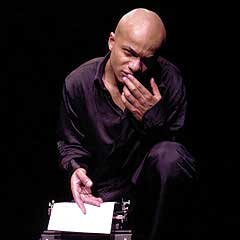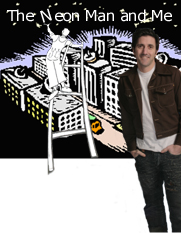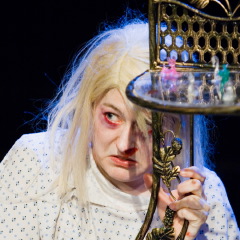Fringe Shorts: Jaime Kleiman
Tune in to this spot for Jaime Kleiman's ongoing coverage of Fringe Festival performances. Check back for regular updates!





Bouffon Glass Menajoree
Brace yourselves, kids, ’cause you’ve never seen anything like this before.
Ten Directions—a film, theatre, and production collaborative founded by Lynn Berg and former Minneapolitan Audrey Crabtree—have created a show that is, to be hyperbolic about it, nothing short of brilliant. Granted, you’ve got to know a wee bit about Tennessee Williams’s The Glass Menagerie and his élan for writing wilting violets whose sexual charms left them ten years ago, during that final impotent encounter down by Moon Lake where her dipsomaniac, closeted gay lover drowned and scarred her for life—but not very much.
I mean, watching three out-there (oh no, they didn’t!) performers in outlandish costumes (Crabtree’s in a diaper, sports a couple bloody gashes from failed suicide attempts, and is wearing a tattered hospital gown, accessorized with one handcuff) do and say things that makes the bawdiest Scrimshaw sketch seem PG by comparison—well, it’s simply marvelous. And yes, I realize that I am writing very long, William S. Burroughs-ian, run-on, screw punctuation, sentences. See the show and you’ll appreciate my attempt to reproduce its scrambling mania in a 500-word review.
It’s somewhat moot to talk about the plot of Bouffon Glass Menajoree, because I’m not sure there is one. It’s more of a depiction of an insular, hellish world in which the iconic characters have been condemned to reenact their ridiculously distraught lives. Besides, I’m afraid that writing about the narrative, such as it is, would give away some of the fun.
The three actors (Berg, Crabtree, and Aimee Leigh German, wonderful physical performers all, use some conventional Fringe pranks: they interact with the audience, curse, masturbate; etc., but their mastery of bouffon grotesqueness transcends the quotidian Fringe hoo-hah. Turns out that deconstructing (if you want to call it that) The Glass Menagerie using this form of distorted, hideously deformed, and vulgar clowning isn’t such a stretch after all. It’s easy to image that Amanda would need gastric bypass surgery and eat chips out of her ample bosom, and that Tom and Laura were sexually stunted, easily aroused miscreants. These larger-than-life characters, as written by Williams or, alternately, by a bunch of monkeys with typewriters who have been injected with experimental chemotherapy drugs, are a hoot. Who knew?
So, if you want your faith in the Fringe Festival restored after seeing solo show after solo show about poor-me because I was (fill in blank), which was really hard growing up in (some podunk town), because everyone hated my race/gender/sexuality/bad poetry, I’M NAKED, JUST COME TO MY SHOW PLEASE!, I’m sure you are exhausted. Bouffon Glass Menajoree will give you the shot of adrenaline you’ve needed all week.
Bouffon Glass Menajoree runs Aug 12 at 1 p.m. Yeah, skip church.
Bedlam Theater, 1501 S. 6th Street, Minneapolis
The Neon Man and Me
Please note: This is a Manna Fest show, not a Fringe show.
Slash Coleman begins his poignant one-man show The Neon Man and Me by impersonating a smarmy French scientist who specializes in anthropomorphizing the mating rituals of elephants. What this has to do with Coleman’s journey from gawky college sophomore to spiritually awakened adulthood is less of a stretch than you’d think. Using the male elephant’s secretion of musth as metaphor (think Calvin Klein’s Obsession For Men dripping down ivory tusks), Coleman elegantly slips into the narrative of his story: how instinctual, ineffable feelings can result in friendships that have the power to outlast even death.
Coleman’s autobiographical story is not so much about him as it is his friend Mark Jamison, a neon sign maker who was electrocuted on a power line more than three years ago. Shortly after Jamison’s death, his wife found out she was pregnant. The Neon Man and Me began as a literary care package for their unborn child.
Hundreds of pages later, Coleman turned those recollections into a play that’s so intimate it often feels like a confession. Gentle anecdotes are bookended by acoustic guitar songs, an homage to the music he and Jamison bonded over almost twenty years ago. Mark, explains Coleman, was a divinely inspired saxophone player. Despite their vastly incongruous religious affiliations—Coleman is Jewish and Mark was Pentecostal—the two became inseparable, both in art and in life.
The memories Coleman recounts are often funny—the time he and Mark crashed at a stranger’s house after a gig and got hit on by his wrinkly mother; the time they were almost expelled from college. Anyone who is far enough away from their early 20s to remember them fondly will feel nostalgic for the seminal events resurrected in Coleman’s performance. The Neon Man and Me>/I> is proof that, as Coleman says, “When you find a friend that hears the same music you do, you’re lucky.” What lovely music it is.
”The Neon Man and Me” runs Aug. 7 at 8:30 p.m., Aug. 9 at 5:30 p.m., and Aug. 11 at 4 p.m. as part of Augsburg College’s inaugural Manna Fest, Augsburg College Foss Center, 22nd Ave. S. & Riverside Dr., Minneapolis.***Note: this is NOT a Fringe Festival show. Visit www.augsburg.edu/mannafest for more info. Tickets: 651-209-6689. uptowntix.com***
True Theater Critic
Polish performer, writer, and director Omar Sangare’s exquisitely crafted solo piece, “True Theatre Critic,” is a rare thing to see at a Fringe Festival. It’s a well-written and deservedly award-winning show that most Fringe-goers will be lucky to see. On the other hand—and maybe it’s because of the subject matter—the story itself held no interest for me. The real reason to go is Sangare himself.
Sangare’s play is about a failed actor turned theatre critic. His theatre critic is not the kind that actors hate—he’s not a sports writer or stringer who’s randomly been assigned to review shows. Sangare’s critic truly cares about the theatre and, like George Bernard Shaw or Michael Feingold, is schooled in dramaturgy and the history of theatre. He has integrity and respect for the people who make theatre happen and wants his own work to reflect that.
But this passion paralyzes him. He is a theatre critic in the truest sense, and the kind I (and many of my colleagues) aspire to be. Sangare’s character experiences a critic’s angst, but does it with a series of delicately controlled gestures, facial movements, and gentle humor.
Sangare is a wonderful, giving performer who stays engaged throughout. Every moment is seamlessly choreographed, and the work he’s doing is just as technical as a dancer’s. One misstep, and the play wouldn’t have the same playful, enchanting quality. Sangare comes from a different school of drama, one that is, unlike ours, more interested in fine-tuning moments and less so in showiness. Acting like his is rarely seen on American stages. At $12, it’s a steal.
Aug. 7 at 10 PM, Aug. 8 at 8:30 PM, and Aug. 11 at 1PM., at Patrick’s Cabaret, 3010 Minnehaha Ave. S. Tickets: (651) 209-6799 or www.uptowntix.com.
Who We Found Instead
The first of many Fringe plays that will no doubt address the Iraq War in some manner or another, Who We Found Instead is an attempt to humanize (and demobilize) two of the U.S. Army’s young recruits. The two-hander by California playwright Ross Howard has, despite the program’s clever cover—Osama bin Laden playing miniature golf with a sinister smile on his face—almost nothing to do specifically with the war in Iraq, or with war in general. Rather, it’s about the impulsivity of the young, validated feelings of helplessness, and yes, love, however strained.
The story is not without promise. Private Simon (Alia Mortenson) and Private Garfunkel (Damon Brook) are two misguided wanna-be heroes who have been shunned by their superiors for being too trigger-happy (in the case of Simon) or too trigger-averse (Garfunkel). Their respective sergeants—also played by Mortenson and Brook—send them to Afghanistan to survey a miniature golf course that “may or may not have been built by the British.” Rumor has it that Osama in a fan of putt putt, and it becomes Simon and Garfunkel’s job to wait for him to appear. They’re armed with nothing but a pack of rainbow Twizzlers, red and blue camping chairs, and confusion.
This “Waiting for Godot”-esque atmosphere is boring, and the characters think so, too. They say as much throughout the show. Predictably, they end up falling in love, or something like that, propelled by fear as the war moves closer to their makeshift oasis. Why Warm Gun Productions is promoting this as a comedy is strange stuff, indeed. Stranger, even, than watching Osama get a hole-in-one.
Aug. 8 at 7 PM, and Aug. 10 at 7 PM, at Pillsbury House Theatre, 3501 Chicago Ave S. Tickets: (651) 209-6799 or www.uptowntix.com.
The World’s Largest Aluminum Foil Ball
“The World’s Largest Aluminum Foil Ball” is an original musical by Right Brain Productions, a company from Des Moines, Iowa. This year, I’m trying to see more shows by out-of-towners, and I had high hopes for this one.
The premise: The world’s largest aluminum foil ball was created decades ago by the original owner of Mom and Pop’s Café, in an attempt to lure hungry drivers in for a steak or two. The public gradually lost interest in this quintessential American roadside attraction (as well as in the café). The owner’s son and his wife now run the money pit with their son, an idiot named Tom Osbourne, named after Nebraska’s “greatest football coach ever,” Tom Osbourne (no relation). The reason for this? None. Like many other bits in this play, there are borderline clever jokes that go nowhere, including some onstage masturbation attempts that could have been funny but instead reminded me of the character Jackie Earle Haley played in the film Little Children. Yuck.
When three UC-Berkeley students on a “Kitschy Road Trip” across America come to visit in their Prius, Mom and Pop welcome them with open arms. (Apparently UC-Berkeley kids are wealthy enough to drive a Prius. Okay.)
The kids look like they’re straight out of a Benetton ad—there’s an Asian American, a Peruvian, and an African American who are named Alcira, Jump, and Ravi, respectively. After they decline alcohol and meat (they’re vegetarian pot-smokers), Alcira takes a photo of the ball with her iPhone and sends it to her friend. Mom and Pop convince themselves that these “non-Americans” are terrorist operatives. Tom, in an attempt to make his father proud, shoots them. The police find out, but when Mom and Pop explain their reasoning, the Sheriff agrees to keep it quiet. “What we did wasn’t murder,” they declare. “It was a patriot act!”
It’s a fun premise, but the music is standard musical theatre schlock. The gags are, for the most part, not very amusing, and the extreme political turn that the musical takes towards the end feels like it belongs in a different play entirely—though I have to admit that the song “What Would He Do?” is a lyric gem.
Essentially, composer/director/writer Robert Jason Ford tried to cram every half-baked, anti-Bush administration rebuttal into one 40-minute show. He makes some good points in an entertaining manner, but the overall result is a sloppy play with amateur performances that didn’t live up to my expectations.
Aug. 7 at 5:30; Aug. 9 at 8:30; and Aug. 11 at 4:00 at Bedlam Theatre, 1501 S. 6th St., Minneapolis. Tickets: (651) 209-6799 or www.uptowntix.com.